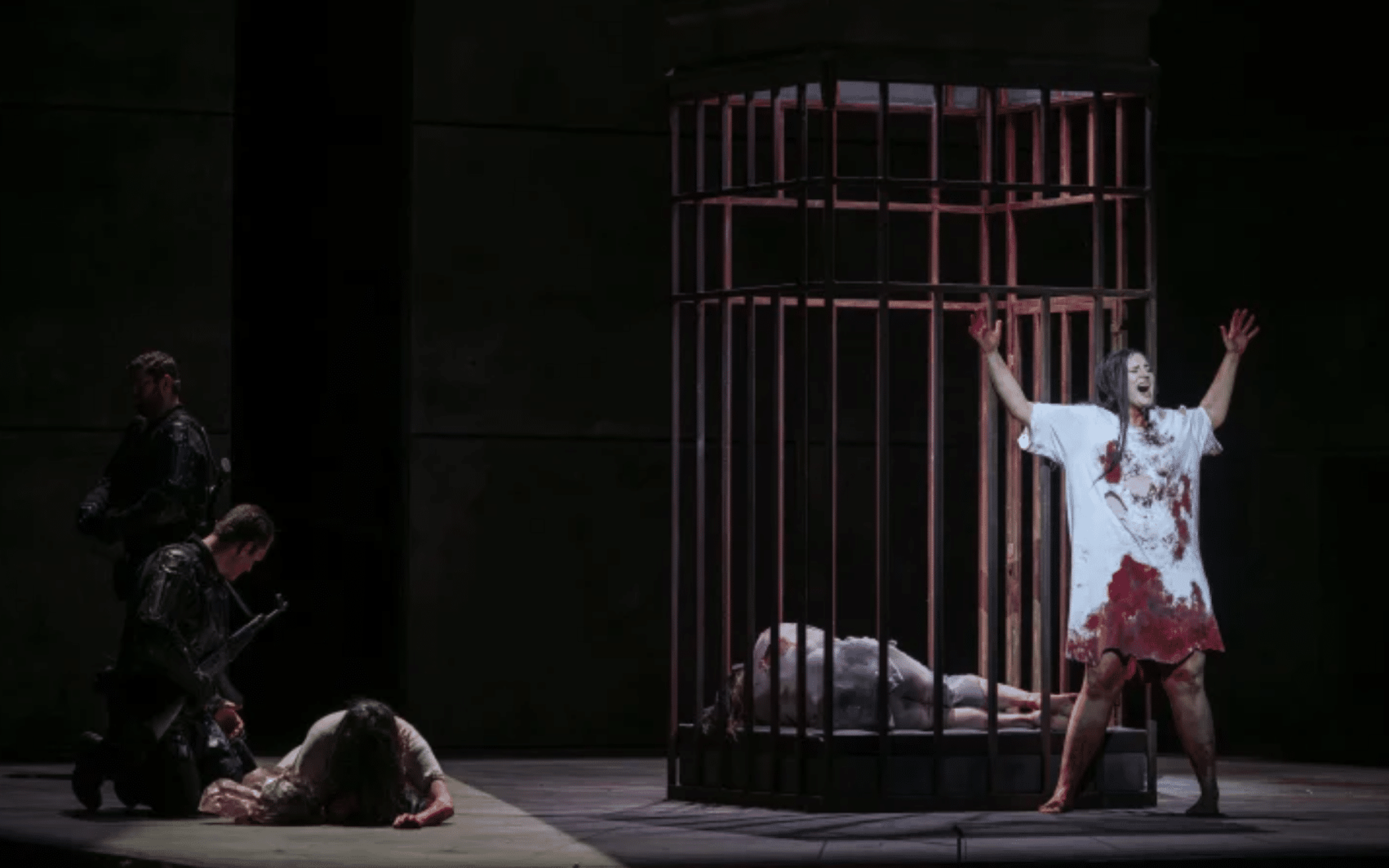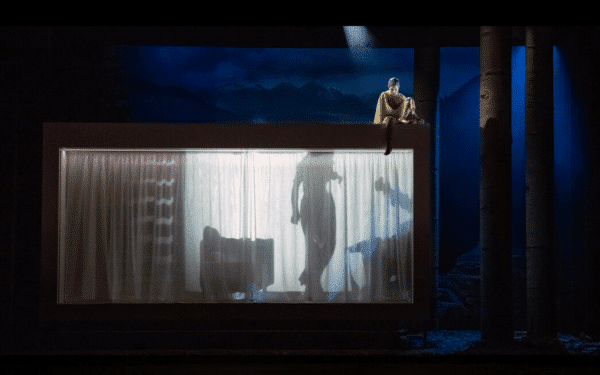Lise Davidsen was orgasmic. As Salome, dressed in contrarian white, she stretched out across the top of the cage housing the prisoner Jochanaan with whom she is obsessed. Enveloped in a cloud of sensuous long black hair, the Norwegian soprano writhed in self-induced sexual ecstasy.
For three minutes that felt like thirty, as Richard Strauss’s increasingly frantic music approached its inevitable climax, coinciding with hers, Herodes and his coterie of hedonistic swingers stood back, shocked at the display. And it takes some doing to shock Herodes.
It takes some doing to shock me. But it did. Spot-lit, nothing was left to the imagination. God help Victoria Sitjà, the revival director who had the unenviable task of putting Davidsen through her rehearsal “paces”.
We are in Paris, France, Opéra Bastille, Richard Strauss’s Salome. The opera where the heroine demands the hero, Jochanaan’s (John the Baptist) head on a plate from her incestuous stepfather the Tetrarch Herodes in return for stripping off and “dancing”.
This is much to the delight of her mother, Herodias, the Tetrarch’s zillionth wife, cast in this production as a brazen soldier-seducing vamp with alarming, bared plastic, metal-nipple-pierced mammaries. Self-supporting weapons of mass destruction in their own right, every good artillery-brandishing officer of the guard deserved favour.
Add to this lascivious mix the silent perma-party taking place behind a window – top, backstage – in which slave girls were serially introduced, raped, murdered, then their naked, bloodstained corpses disposed of main stage right in a lime pit, by a ghostly army of yellow hazmat-suited apparatchiks.
Round off with a mass orgy scene when Salome seduces pretty much every male member of the cast and emerges from the writhing, frenzied huddle, her torn white shift smeared in blood.
This production was meant to shock. And did. The question for the production team, addressed later, is, was it all gratuitous attention seeking – a “look at me” shockeroo – or did the excess serve a dramatic purpose?
As I flicked through my programme at the interval, I searched for the name of the Intimacy coordinator. En Amérique they are partout these days. Zut, alors! Rien. Welcome to the nihilistic world of American Director, Lydia Steier. Aided and abetted by German Dramatist, Maurice Lenhard. Libertine Oscar Wilde, who wrote the original version upon which Strauss based his score and libretto, could be heard shouting “bravo” from his grave.
For those unfamiliar with the storyline of Strauss’s Salome click here. It is a Met synopsis. Its clarity is a virtue.
This production premiered in Paris in 2022 with South African soprano Elza van den Heever in the title role. For any director, the character of Salome is partly dictated by the singer. Neither van der Heever nor Davidsen would be convincing, put-upon blushing flowers.
Conventionally, in other recent productions, the path followed has been to cast Salome as a modern victim of abuse, corrupted by an uncaring mum and up-skirting stepfather. A walk down political correctness alley.
Steier’s Salome is someone very different. Clearly on a mission. To bring down the decadent, nihilist society of Herodes and his acolytes. They are a crew for whom paying off the likes of Stormy Daniels would certainly not be deemed a criminal offence.
I think Steier is looking back to the time the opera was written, 1905. Strauss referred to Salome as having “the voice of Isolde”. Tragic and powerful – not a put-upon girlie-victim. It was the era of the split of the Vienna Secession, the arts movement that in 1897 revolted against what they saw as the stifling culture of the Habsburg era and paved the way to modernism.
The power Strauss’s music lends to Salome’s voice answers the question every director of this opera should ask: what is Salome for? She is the personification of that and the broader political revolt that was to come.
Isaiah Berlin, probably the 20th century’s most lucid philosopher, put it nicely in his 1953 essay, The Hedgehog and the Fox. The fox knows many things – and dashes wildly hither and thither, achieving not a lot, whereas the hedgehog knows only one big thing and pursues its course resolutely. Steier’s Salome is a hedgehog.
That single purpose is to tear down the corrupt regime of Herod. She will stop at nothing to achieve that end. All her actions, from the temptation of Narraboth, the infatuated soldier seduced into bringing Jochanaan into her presence at the beginning of the opera, through her fantasy of having sex with the prophet, her shocking erotic excesses and that final, impossible demand, the head of Jochanaan, so that she may kiss his lips, are laser-focused on destroying the corrupt society her stepfather maintains.
When Herod executes Jochanaan, he is sealing his own fate. He knows it. The game is up. He issues the order, “Kill that woman”, but it is too late. In this production, as he walks away in the closing moments he is assassinated – almost as an aside.
That is perhaps a mistake. Probably my only quibble. Better to leave the audience to shape in their own minds what happens next to Herodes. It is obvious and does not need a covert, almost casual knife in the ribs on the stairs stage left as the curtain falls to make the point.
Davidsen was in fine voice and delivered the Strauss score with all the power and authority she could muster. A full broadside. Her forward calendar includes the title role in Puccini’s Tosca and Leonore in Beethoven’s Fidelio at New York’s Met through fall 2024 and Spring 2025. Can guess who will be there?
Herodias, Russian mezzo-soprano Ekaterina Gubanova, was well directed. The awful mother starts off encouraging her daughter in revenge for her husband’s philandering, but by the end is as much a target in Salome’s sights as Herodes. Gubanova was constantly engaged, when not singing, in archly eyeing up the boys in uniform with the big guns. Yes, we got the point.
Herodes, German tenor, Gerhard Siegel, brought his huge experience gained in a career rooted in German Staatsoper, then from 2015 in international appearances, to bear. Siegel is a consummate actor and he portrayed Herodes’ transition from swagger, through desperation to despair convincingly.
With British conductor Mark Wigglesworth in the pit, the Orchestre de l’Opéra national de Paris was under a capable baton. Wigglesworth, a devoted Mahlerian – well, not that far from Strauss – has had a hectic career in Europe and the UK. His tenure as musical director at English National Opera was short. Appointed in 2015 he took issue with economising measures at the perma-economically challenged company and resigned within a year.
Having successfully helped build the reputation of the Bournemouth Symphony Orchestra he has recently been appointed its chief conductor. Wigglesworth will also become chief conductor of the Adelaide Symphony Orchestra from 2025 onwards. In the eyes of Isaiah Berlin, he is the musical fox personified, on air miles.
Steier’s casual disregard for human life seemed unthinkable when her production first hit the stage in 2022. Her backdrop yellow hazmat automata disposing monotonously of young girls’ corpses were surely metaphorical.
The emergence of Hamas terrorists from their Gaza tunnels on 7 October 2023, rampantly pursuing the mindless slaughter, mutilation, sexual abuse and torture of defenceless victims, ranging from babies to pensioners, shattered that illusion.
That’s if it had not already been broken by the evidence emerging from Ukraine of the systematic rape of male civilian prisoners and other atrocities.
Whatever was left of our post-war age of innocence is over. Lydia Steier’s totally mesmerising Salome in Paris is no longer a premonition. It is of this time, and all the more compelling for that.
And another thing!
It’s not often you see the Chairman of English National Opera (ENO) appearing in Court Number 1, The Old Bailey, London raising blue murder.
More accurately, murder perpetrated by those street-cheered heroes of our NHS-fixated age – doctors. Dr Harry Brunjes, as well as presiding over ENO’s turbulent present, delves into a gruesome medical past.
Dial Medicine for Murder is an engaging two-man show narrating the sagas of serial killers Dr John Bodkin Adams (160 + suspected victims and Dr Harold Shipman (450 +).
Dr. Harry Brunjes, who went on to forge a successful business career – and Dr Andrew Johns, a forensic psychiatrist, who went on to forge a successful career in forensic psychiatry, first met at Guys Hospital as junior doctors.
Brunjes comes from a Scottish showbiz family – The Singing Scott Brothers, met his wife, Jacquie, while tramping summer boards in variety and cannot resist the lure of performance.
He and Johns have perfected a one-hour, illustrated double-act lecture setting out the killer careers of Bodkin Adams and Shipman and posing the question, could it happen today?
The Bodkin Adams story is of a self-entitled, would-be member of the Eastbourne genteel set, killing patients, forging wills and ordering tailoring at his patients’ expense, enticing vulnerable widows to give him their Rolls Royces. Shipman was a troubled loner who ‘put patients out of their misery’.
Dial Medicine for Murder has been a huge success, having been performed regularly since 2015 in nearly 60 venues, including the Edinburgh Festival Fringe. Set in the very court where Bodkin Adams was acquitted added chill and thrill.
If the show ever comes your way – Brunjes and Johns are hoping to take it back to New York in the autumn – dial ‘H’ for Harry and ‘J’ for John to enjoy a spellbinding insight into the minds of killers Bodkin Adams and Shipman.
We are reminded at the end that Harold Shipman is the only British doctor to ever stand convicted of murdering a patient. But as all NHS doctors are virtual these days, that probably no longer matters.
Write to us with your comments to be considered for publication at letters@reaction.life





